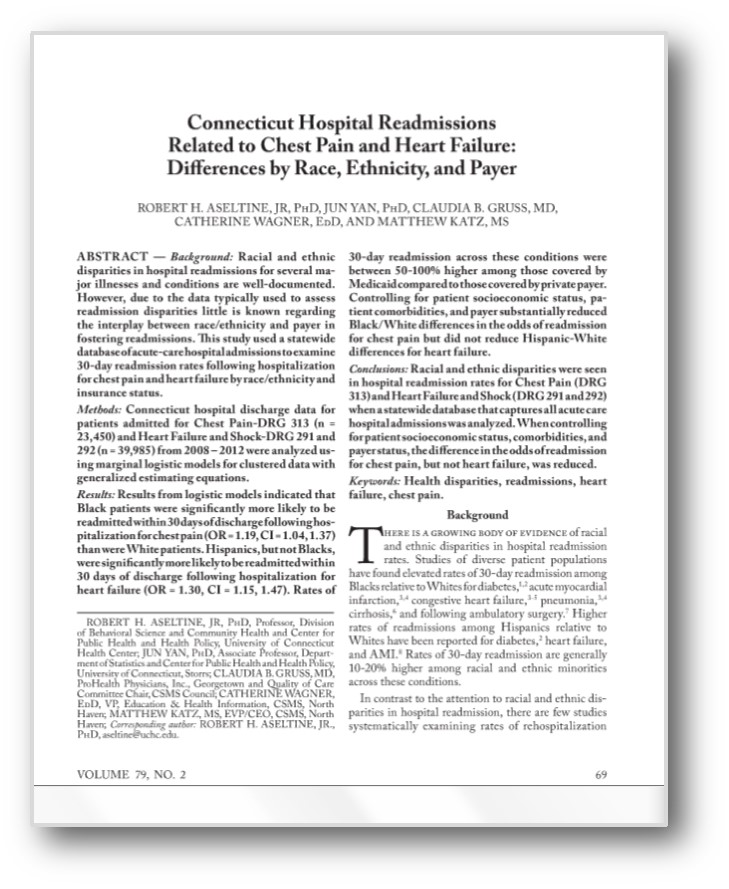Racial, Ethnic Disparities Common in CT Hospital Readmissions, Study Finds
/An Hispanic patient hospitalized in Connecticut for heart failure is 30 percent more likely than a White patient to end up back in the hospital within a month, according to a study published in Connecticut Medicine, the journal of the Connecticut State Medical Society. The study also found that a Black patient hospitalized for chest pain is 20 percent more likely to be readmitted within 30 days after discharge.
The study was based on an analysis of the Connecticut Hospital Inpatient Discharge Database -admissions to Connecticut hospitals from 2008-2012. The findings, the study noted, “should serve as a catalyst for further investigation of the interplay between patient characteristics, hospital practices, community-based resources, and insurance coverage” in fostering “racial and ethnic disparities in health and healthcare.”
The multi-year study discovered significant and pronounced disparities in readmission rates for Black and Latino patients compared to White patients in 9 of 10 major diagnostic categories.
The Connecticut State Medical Society hosted a well-attended symposium last week highlighting its multi-year research into racial and ethnic disparities in readmissions. The symposium, funded by the Connecticut Health Foundation, brought together physicians, nurses, patients, and other stakeholders from across the state. The stakeholders had an opportunity to review and discuss the CSMS research data, and also provided insight and interpretations of the disparities. The feedback will be integrated into clinical recommendations for care delivery models that may help to reduce the level of disparity in hospital readmission rates.
The symposium was designed to provide an opportunity to take a fresh look at these readmission disparities and determine more effective ways to address them. Stakeholders included physicians and other licensed health care providers; social service providers; healthcare/social service administrators, leaders, and managers; lawmakers and policy analysts; patients and their family members; healthcare consumers and patient advocates. It focused on documenting potential best practices of the four conditions with the greatest racial and ethnic disparities in readmission rates, as determined in the study: Uncomplicated Delivery, Joint Replacement Surgery, Heart Failure & Chest Pain, and Digestive Disorders.
 The study also noted that “barriers to accessing community based care among Connecticut Medicaid beneficiaries are well-documented, often leaving such patients with few options other than hospital care for both urgent and non-urgent conditions.”
The study also noted that “barriers to accessing community based care among Connecticut Medicaid beneficiaries are well-documented, often leaving such patients with few options other than hospital care for both urgent and non-urgent conditions.”
The study’s authors noted that “this study adds to a growing body of evidence on disparities in hospital readmissions in several important respects.” First and foremost, they point out, “racial and ethnic disparities observed in this study were considerably more pronounced than disparities generally reported in previous studies.”
“We’re seeing large disparities in readmissions for a number of conditions,” Robert Aseltine, the study’s lead author and professor of behavioral science and community health at the University of Connecticut Health Center, told the Connecticut Health Investigative Team (C-HIT). “There’s no one factor that jumps out. There’s no simple answer. ” Co-existing health conditions and socioeconomic status, for example, “don’t explain everything away.”
In March 2014, a report by Mathematica Policy Research for the Robert Wood Johnson Foundation indicated that the U.S. Department of Health and Human Services observed a year earlier that “while overall quality is improving, access is worse and there has been no improvement in lessening disparities.” The report goes on to point out that there “appears to be a shift from the concept of disparities to one of equity. The shift provides more focus on action and social justice relevant to a wide variety of subpopulations.”
In 2010, when “nearly half of U. S. physicians identify language or cultural communication barriers as obstacles to providing high-quality care,” physician adoption of practices to overcome such barriers was described as “modest and uneven, according to a national study by the Center for Studying Health System Change (HSC).
The new Connecticut study was conducted by Robert H. Aseltine, Jr, PhD, Jun Yan, PhD, Claudia B. Gruss, MD, Catherine Wagner, EdD, and Matthew Katz, MS.





























